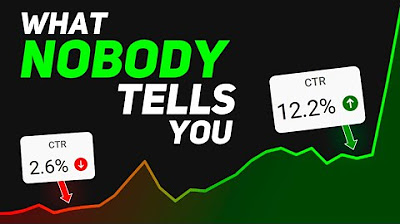The Difference Between Good & GREAT Sellers
Summary
TLDRThe video script highlights the distinction between good and great sellers, emphasizing the importance of tenacity and effective follow-up. It stresses that great sellers persist in uncomfortable sales situations and continue to engage with prospects, even after multiple rejections. The key to successful follow-up is adding value at each interaction, ensuring every contact moves the prospect closer to a decision. The script illustrates how to provide value by analyzing a prospect's current situation and offering insights that can solve their problems, rather than merely pushing for a sale.
Takeaways
- 🔍 The key differentiator between good and great sellers is their follow-up and tenacity to stay in deals even when uncomfortable.
- 🏃♂️ Great sellers don't give up after a few rejections; they continue to pursue prospects, unlike those who may stop after a few 'no's.
- 🔥 The importance of maintaining contact with 'hot' prospects is emphasized, as they can cool down quickly if not followed up properly.
- 🤔 The script suggests that unsuccessful sellers often believe the prospect's excuse of needing more time, leading to lost opportunities.
- 🎨 The art of follow-up involves a balance between being persistent and not being annoying, which can be achieved through value-added follow-ups.
- 💡 Value-added follow-ups mean providing something of value to the prospect with each interaction, moving them closer to a buying decision.
- 🚫 Avoid being a pest by ensuring that every follow-up interaction is important to the prospect and contributes to solving their initial problem.
- 📈 The example of following up on a Facebook ad proposal shows how to add value by analyzing the prospect's current ads and competitors, offering concrete improvements.
- 🤝 The focus should be on serving the prospect rather than just selling, which means showing up with solutions and value, not just asking for a sale.
- 📢 The script encourages viewers to engage with the content by liking, subscribing, and leaving comments for further interaction.
Q & A
What is the key differentiator between good and great sellers according to the transcript?
-The key differentiator is follow-up and having the tenacity to stay in the deals even when they're uncomfortable, as opposed to giving up after a few rejections.
Why do most people stop following up on hot prospects?
-Most people stop following up because they believe the prospect's statement that they need more time to think, and they don't realize that the prospect's interest has cooled down.
What is the concept of 'value added follow-up' mentioned in the transcript?
-'Value added follow-up' is the strategy of providing value to the prospect with every interaction, ensuring that each follow-up contributes to solving the prospect's problem and moves them closer to a buying decision.
How can a salesperson avoid being perceived as annoying during follow-ups?
-A salesperson can avoid being annoying by ensuring that every follow-up provides value to the prospect, focusing on serving the prospect's needs rather than solely on making a sale.
What is an example of a value-added follow-up in the context of selling Facebook ads services?
-An example of a value-added follow-up could be analyzing the prospect's current Facebook ads, identifying opportunities for improvement, and presenting these insights to the prospect as part of the follow-up process.
Why is it important to show up to serve rather than just to sell during follow-ups?
-Showing up to serve ensures that the salesperson is focused on the prospect's needs and providing solutions, which builds trust and increases the likelihood of a successful sale, rather than just pushing for a transaction.
What is the significance of adding value as you follow up, as mentioned in the transcript?
-Adding value as you follow up helps maintain the prospect's interest and engagement, demonstrating that the salesperson is invested in the prospect's success and not just in making a sale.
How can analyzing a prospect's competitors contribute to effective follow-ups?
-Analyzing a prospect's competitors allows the salesperson to identify strategies that could be beneficial for the prospect, providing actionable insights that can be used to enhance the sales pitch and follow-up conversations.
What is the potential downside of not providing value during follow-ups?
-Not providing value during follow-ups can lead to the prospect ghosting the salesperson, screening their calls, and ignoring their emails, ultimately resulting in the loss of a potential sale.
How can a salesperson estimate potential savings for a prospect during a follow-up?
-A salesperson can estimate potential savings by analyzing the prospect's current ad spend and identifying inefficiencies or areas for improvement, then presenting these findings as part of the follow-up to demonstrate the value of their services.
What is the role of persistence in the sales process as discussed in the transcript?
-Persistence plays a crucial role in the sales process as it allows salespeople to continue engaging with prospects even after initial rejections, potentially leading to a sale by maintaining the relationship and providing ongoing value.
Outlines

This section is available to paid users only. Please upgrade to access this part.
Upgrade NowMindmap

This section is available to paid users only. Please upgrade to access this part.
Upgrade NowKeywords

This section is available to paid users only. Please upgrade to access this part.
Upgrade NowHighlights

This section is available to paid users only. Please upgrade to access this part.
Upgrade NowTranscripts

This section is available to paid users only. Please upgrade to access this part.
Upgrade Now5.0 / 5 (0 votes)





